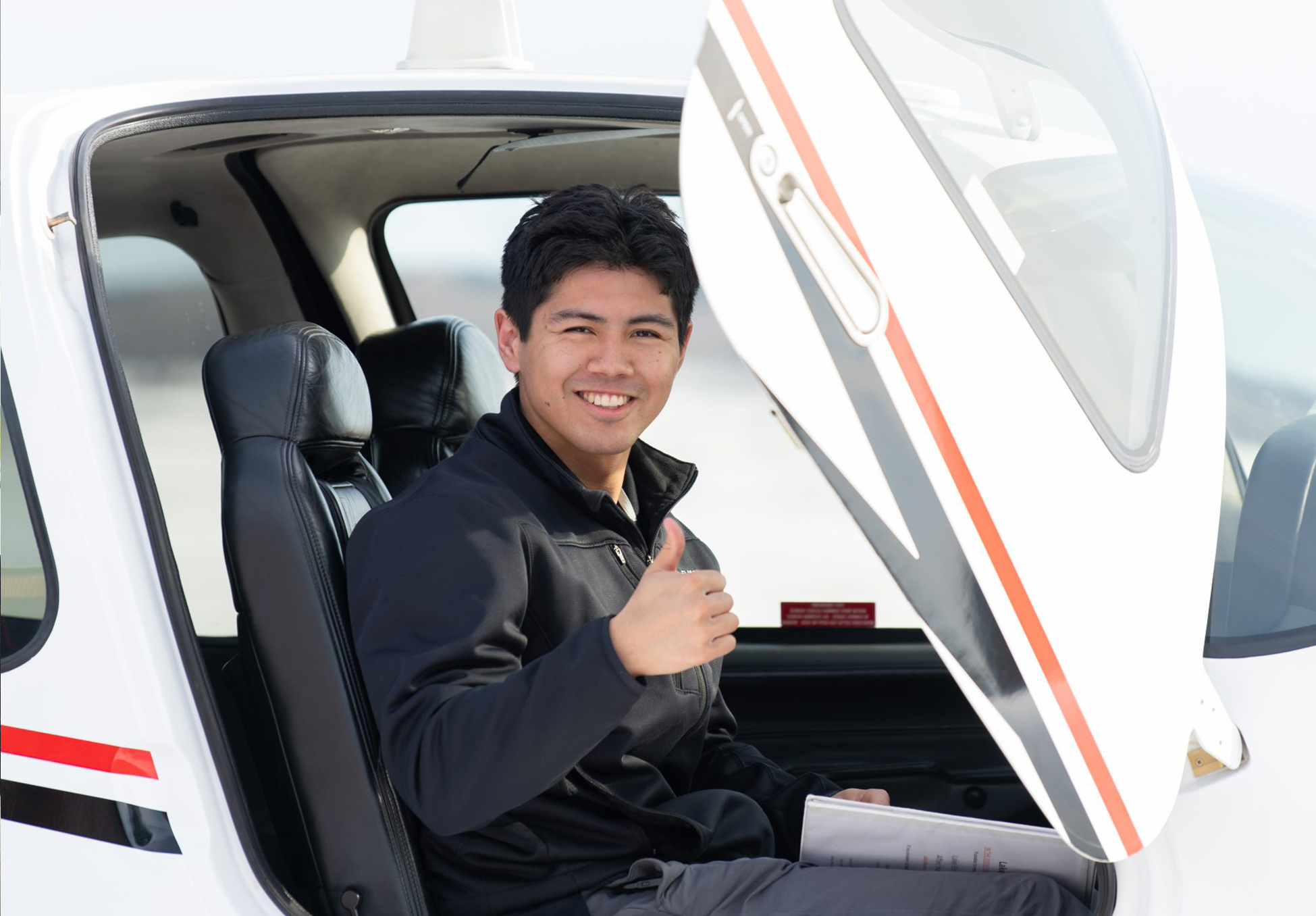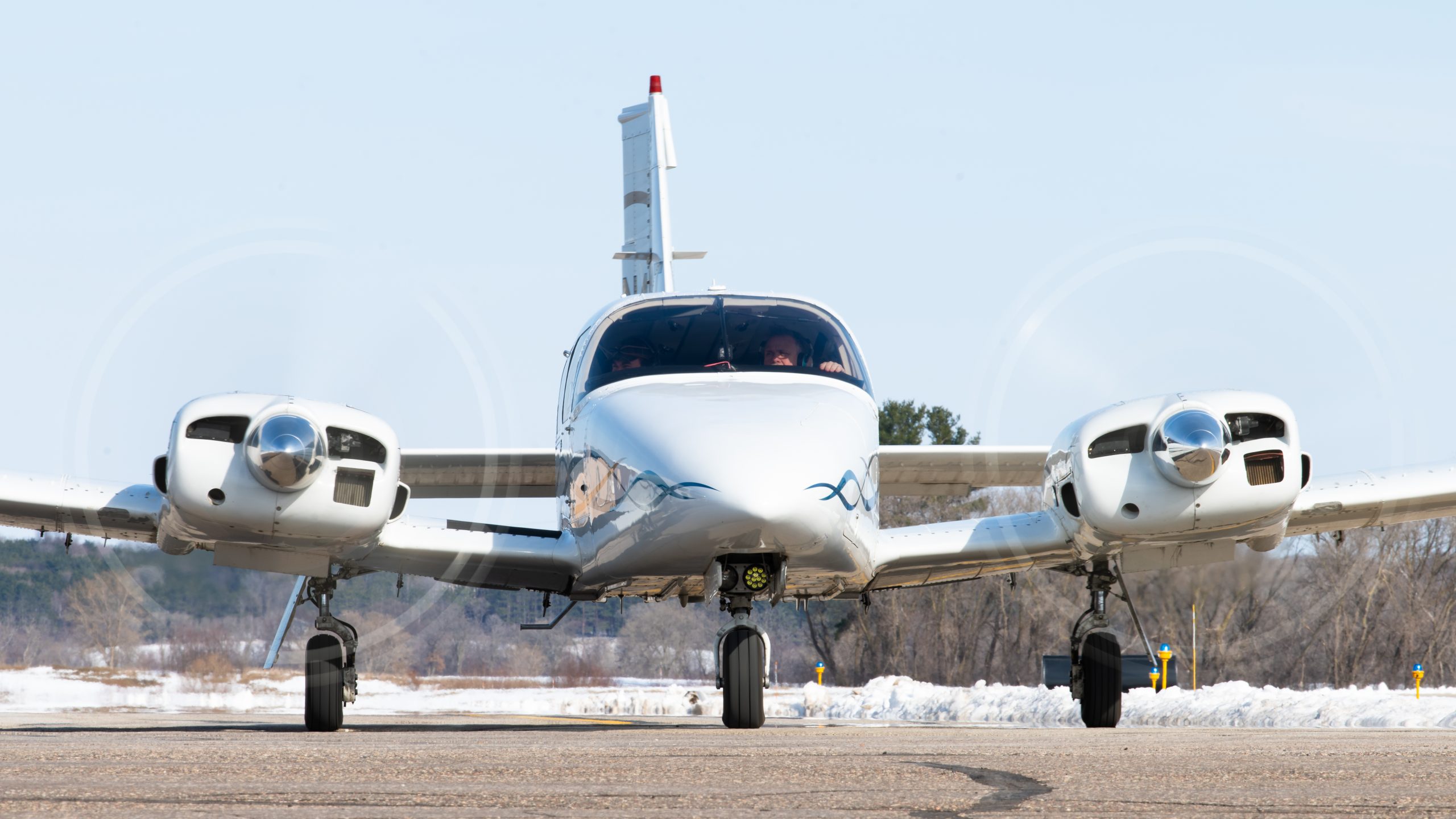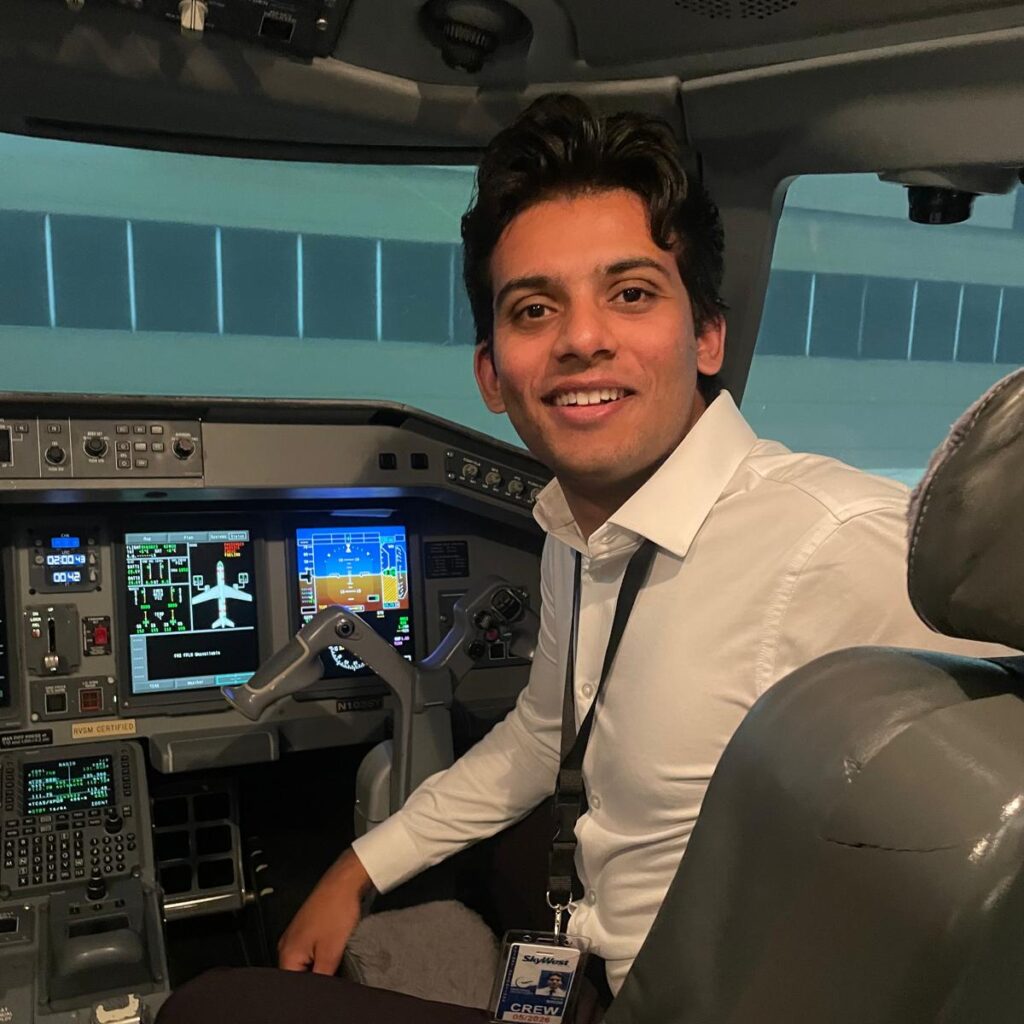If you are looking to improve your piloting skills by earning additional ratings, we can help you there too! We also offer Flight Reviews, Complex & High Performance Training.
-
- Private Pilot License
The FAA Private Pilot Certificate is the foundation of general aviation, allowing you to fly single-engine aircraft for personal, recreation, or business use. Training consists of ground and flight instruction covering essential topics such as aerodynamics, navigation, weather, and aircraft systems. Students must complete a minimum of 35 flight hours (Part 141), including solo and cross-country flights, and pass both a written knowledge test and a checkride with a designated FAA examiner. This certification provides the freedom to fly anywhere in the U.S. and serves as the first step toward more advanced ratings and a career in aviation.
-
- Instrument Rating
The Instrument Rating enhances your skills by allowing you to fly in a wider range of weather conditions using only your aircraft’s instruments. This training focuses on advanced navigation, meteorology, and air traffic control procedures, preparing you to operate safely in low visibility and cloud cover. To earn this rating, pilots must complete at least 35 flight hours (Part 141) instrument flight time, pass a written knowledge test, and successfully complete a checkride with an FAA designated examiner. While not required for private pilots, an Instrument Rating significantly improves safety, proficiency, and overall flying confidence, making it a priceless valuable addition to any pilot’s qualifications.
-
- Commercial Pilot License
The Commercial Pilot Certificate allows you to fly for compensation or hire, opening the door to a professional aviation career. Training focuses on mastering complex aircraft operations, precision maneuvers, and advanced flight skills. To qualify, pilots must log at least 250 total flight hours, including 100 hours as pilot-in-command and 50 hours of cross-country time. Additionally, you’ll need to pass a written knowledge test and a checkride with an FAA designated examiner. This certification is a crucial step for those pursuing careers as corporate, airline, or charter pilots.
-
- Commercial Multi-Engine Add-on
The multi-engine add-on rating expands your capabilities by allowing you to fly aircraft with more than one engine. This training emphasizes multi-engine aerodynamics, engine-out procedures, and advanced aircraft systems, to further enhance your skills in regards to safety. There is no additional written exam required and no minimum hour requirement, but pilots must complete the flight training and pass a checkride with an FAA examiner. A multi-engine rating is essential for pilots looking to advance into commercial aviation and explore career opportunities in the aviation industry.
-
- Certified Flight Instructor Ratings (CFI, CFII, MEI)
Becoming an FAA Certified Flight Instructor (CFI) is a rewarding way to build flight experience while teaching the next generation of pilots. As a CFI, you’ll refine your own flying skills while gaining valuable hours that count toward an airline or professional aviation career. Many instructors choose to further their expertise by obtaining the Certified Flight Instructor – Instrument (CFII) rating, which allows them to teach instrument flight, and the Multi-Engine Instructor (MEI) rating, which qualifies them to train pilots in multi-engine aircraft. Each certification requires rigorous flight training, a written knowledge test, and a checkride with an FAA examiner. Earning these instructor ratings not only enhances your teaching capabilities but also expands your career opportunities in aviation.
FAA Part 141 Private Pilot Training at Lake Elmo Aero
Earning your Private Pilot Certificate (PPL) under FAA Part 141 at Lake Elmo Aero is the first step toward unlocking the freedom of flight. As an FAA-approved flight school, our structured Part 141 Private Pilot Program follows a streamlined syllabus (14 CFR § 141.55) that allows students to earn their certificate in as little as 35 flight hours, compared to the 40-hour minimum required under Part 61 (14 CFR § 61.109). With a focus on safety, precision, and real-world skill development, our program provides the ideal foundation for both recreational pilots and those pursuing a professional aviation career.
Course Structure & Training Requirements
Lake Elmo Aero’s Garmin-equipped aircraft offer the perfect platform for learning, providing state-of-the-art avionics and a user-friendly training environment. Our program includes:
- Fundamentals of Flight – Mastery of basic aerodynamics, aircraft control, and maneuvering in all phases of flight.
- Takeoffs, Landings & Traffic Patterns – Development of precise aircraft handling at various airports and conditions.
- Navigation & Cross-Country Flights – Training in pilotage, dead reckoning, GPS navigation, and flight planning under 14 CFR § 61.93.
- Weather & Aeronautical Decision-Making – In-depth understanding of FAA weather resources, aeronautical charts, and risk management.
- Emergency Procedures – Training in engine failures, system malfunctions, and off-airport landings to ensure pilot confidence in any scenario.
Testing & Certification
To earn a Private Pilot Certificate under Part 141, students must:
- Be at least 17 years old (or 16 for solo flight under 14 CFR § 61.103).
- Hold at least a Third-Class Medical Certificate (14 CFR § 61.23).
- Complete a minimum of 35 ground training hours per the syllabus.
- Complete a minimum of 35 flight hours, including:
- 20 hours of dual instruction covering all FAA-required maneuvers.
- 5 hours of solo flight, including a cross-country flight of at least 150 nautical miles with full-stop landings at three airports (14 CFR § 61.109).
- Pass the FAA Private Pilot written knowledge test (14 CFR § 61.105).
Successfully complete the FAA Private Pilot Practical Test (checkride), demonstrating proficiency in all required maneuvers under 14 CFR § 61.107.

FAA Part 141 Instrument Rating at Lake Elmo Aero
Earning an Instrument Rating (IFR) under FAA Part 141 at Lake Elmo Aero is the key to unlocking a new level of piloting skill and capability by using your instruments to fly the aircraft. Our FAA-approved Part 141 Instrument Training Program allows students to qualify with a reduced minimum flight time—35 hours (instead of 40 under Part 61)(14 CFR § 61.65).
Course Structure & Training Requirements
Our Garmin-equipped Cessna and Cirrus Aircraft provide the perfect platform for instrument flight training, ensuring students gain real-world experience with glass cockpit avionics and precision navigation in the Garmin G3X and Perspective + platforms. The curriculum covers:
- Instrument Flight Procedures – Mastery of flight solely by reference to instruments, including climbs, descents, turns, and holding patterns.
- Precision & Non-Precision Approaches – Proficiency in ILS, GPS (RNAV), VOR, and Localizer approaches, as required under 14 CFR § 61.65(d).
- Enroute Navigation & IFR Cross-Country Flights – Training in ATC communication, IFR charts, SID/STAR procedures, and long-range flight planning.
- Emergency & Abnormal Procedures – Handling of unusual attitudes, loss of communication scenarios, and system failures.
- Regulations & Weather Theory – In-depth study of 14 CFR Part 91 IFR regulations, FAA weather services, and advanced meteorology for flight planning.
Testing & Certification
To earn an Instrument Rating under Part 141, students must:
- Hold at least a Private Pilot Certificate (PPL)
- Complete a minimum of 35 hours of instrument training (14 CFR § 141.65).
- Pass the FAA Instrument Rating Knowledge Test (14 CFR § 61.65(a)(4)).
- Complete an instrument cross-country flight of at least 250 nautical miles, with three different approaches at three different airports (14 CFR § 61.65(d)(2)).
- Pass the FAA Instrument Rating Practical Test (checkride) with an examiner, demonstrating precision instrument flying, approach procedures, and emergency handling (14 CFR § 61.65(a)(7)).

FAA Part 141 Commercial Pilot Training at Lake Elmo Aero
For pilots ready to take their skills to a professional level, Lake Elmo Aero’s FAA Part 141 Commercial Pilot Training Program provides a structured and efficient path to earning your Commercial Pilot Certificate (CPL). Whether you’re pursuing a career in commercial aviation, a charter operator, or any other pilot position, our FAA-approved Part 141 curriculum (14 CFR § 141.55) is designed to develop the precision, decision-making, and advanced flight skills required for commercial operations.
Under Part 141, pilots can qualify for their Commercial Pilot Certificate with 190 flight hours, compared to 250 hours under Part 61 (14 CFR § 61.129), offering a more efficient and cost-effective route to becoming a professional pilot.
FAA Part 141 Commercial Pilot Training (Single-Engine)
Our FAA Part 141 Commercial Single-Engine Pilot Training Program develops the advanced skills required for professional flying. The curriculum includes:
- Complex Aircraft Training – Proficiency in aircraft with retractable landing gear, controllable-pitch propellers, and flaps (14 CFR § 61.129(a)(3)(ii)).
- Advanced Flight Maneuvers – Mastering steep turns, chandelles, lazy eights, eights-on-pylons, and power-off accuracy landings as required under 14 CFR § 61.127(b).
- Precision Navigation & Cross-Country Flying – Including day and night VFR cross-country flights of at least 100 nautical miles each (14 CFR § 61.129(a)(4)).
Regulations & Professionalism – Understanding FAA commercial flight regulations, aeronautical decision-making, and operational safety.
Testing & Certification
To earn a Commercial Pilot Certificate under Part 141, students must:
- Be at least 18 years old and hold at least a Second-Class Medical Certificate (14 CFR § 61.23).
- Complete a minimum of 190 flight hours, including:
- 100 hours as pilot-in-command (PIC).
- 50 hours of cross-country time (10 of which must be in an airplane).
- 10 hours of complex or technically advanced aircraft (TAA) training.
- Pass the FAA Commercial Pilot Knowledge Test (14 CFR § 61.125).
- Successfully complete the FAA Commercial Pilot Practical Test (checkride), demonstrating proficiency in all required maneuvers under 14 CFR § 61.127 & § 61.129.
For the Multi-Engine Add-On, no additional written exam is required. The final step is passing the FAA Commercial Multi-Engine Practical Test, where pilots demonstrate multi-engine flight proficiency.
Your Career Path After Commercial Training
With a Commercial Pilot Certificate, pilots are eligible to fly for hire and pursue careers in:
- Charter & Corporate Aviation
- Aerial Surveying & Banner Towing
- Agricultural & Cargo
- Commercial Aviation
- Certified Flight Instruction
- Many pilots continue training for their Airline Transport Pilot (ATP) Certificate under 14 CFR § 61.159 or enroll in a Restricted ATP (R-ATP) program under 14 CFR § 61.160.
- While training at Lake Elmo Aero, you will be a part of our community that is full of career mentoring support to make sure you are on the right track to reach your aviation goals.

Train with the Best at Lake Elmo Aero
At Lake Elmo Aero, we are dedicated to training the next generation of professional pilots. With the best aircraft, instructors, and training environment in the Midwest, we provide the tools and experience you need to launch your aviation career or explore the world of general aviation and how it can benefit you.
Take your training to the next level—enroll today!